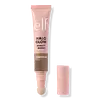What's inside
What's inside
 Key Ingredients
Key Ingredients

 Benefits
Benefits

 Concerns
Concerns

 Ingredients Side-by-side
Ingredients Side-by-side

Water
Skin ConditioningHydrogenated Didecene
Skin ConditioningIsododecane
EmollientGlycerin
HumectantPropylene Glycol
HumectantDimethicone
EmollientCetyl PEG/PPG-10/1 Dimethicone
EmulsifyingTrimethylsiloxysilicate
EmollientSqualane
EmollientMica
Cosmetic ColorantIsoamyl Laurate
EmollientPEG-10 Dimethicone
Skin ConditioningHydrogenated Styrene/Isoprene Copolymer
Sodium Chloride
MaskingPolyglyceryl-4 Isostearate
EmulsifyingDisteardimonium Hectorite
StabilisingSynthetic Sapphire
Caprylic/Capric Triglyceride
MaskingPropylene Carbonate
SolventTocopherol
AntioxidantHelianthus Annuus Seed Oil
EmollientCalendula Officinalis Flower Extract
MaskingPolymethylsilsesquioxane
Hydrolyzed Sodium Hyaluronate
Skin ConditioningSodium Hyaluronate
HumectantDisodium EDTA
Caprylyl Glycol
EmollientPhenoxyethanol
PreservativeEthylhexylglycerin
Skin ConditioningTriethoxycaprylylsilane
Aluminum Hydroxide
EmollientPentaerythrityl Tetra-Di-T-Butyl Hydroxyhydrocinnamate
AntioxidantCI 77891
Cosmetic ColorantIron Oxides
Water, Hydrogenated Didecene, Isododecane, Glycerin, Propylene Glycol, Dimethicone, Cetyl PEG/PPG-10/1 Dimethicone, Trimethylsiloxysilicate, Squalane, Mica, Isoamyl Laurate, PEG-10 Dimethicone, Hydrogenated Styrene/Isoprene Copolymer, Sodium Chloride, Polyglyceryl-4 Isostearate, Disteardimonium Hectorite, Synthetic Sapphire, Caprylic/Capric Triglyceride, Propylene Carbonate, Tocopherol, Helianthus Annuus Seed Oil, Calendula Officinalis Flower Extract, Polymethylsilsesquioxane, Hydrolyzed Sodium Hyaluronate, Sodium Hyaluronate, Disodium EDTA, Caprylyl Glycol, Phenoxyethanol, Ethylhexylglycerin, Triethoxycaprylylsilane, Aluminum Hydroxide, Pentaerythrityl Tetra-Di-T-Butyl Hydroxyhydrocinnamate, CI 77891, Iron Oxides
Methyl Methacrylate Crosspolymer
Cetearyl Ethylhexanoate
EmollientCetyl Ethylhexanoate
EmollientDimethicone
EmollientPolyethylene
AbrasiveDipentaerythrityl Hexa C5-9 Acid Esters
Skin ConditioningNeopentyl Glycol Diheptanoate
EmollientHydrogenated Coco-Glycerides
EmollientOzokerite
Emulsion StabilisingTalc
AbrasiveBis-Behenyl/Isostearyl/Phytosteryl Dimer Dilinoleyl Dimer Dilinoleate
EmollientMicrocrystalline Wax
Emulsion StabilisingPentaerythrityl Tetraethylhexanoate
EmollientCeresin
Emulsion StabilisingPhytosteryl Macadamiate
Skin ConditioningCetyl PEG/PPG-10/1 Dimethicone
EmulsifyingPolyglyceryl-4 Isostearate
EmulsifyingHexyl Laurate
EmollientPhenoxyethanol
PreservativeSorbic Acid
PreservativeTocopheryl Acetate
AntioxidantSimmondsia Chinensis Seed Oil
EmollientTocopherol
AntioxidantTitanium Dioxide
Cosmetic ColorantMica
Cosmetic ColorantIron Oxides
CI 77492
Cosmetic ColorantCI 77499
Cosmetic ColorantMethyl Methacrylate Crosspolymer, Cetearyl Ethylhexanoate, Cetyl Ethylhexanoate, Dimethicone, Polyethylene, Dipentaerythrityl Hexa C5-9 Acid Esters, Neopentyl Glycol Diheptanoate, Hydrogenated Coco-Glycerides, Ozokerite, Talc, Bis-Behenyl/Isostearyl/Phytosteryl Dimer Dilinoleyl Dimer Dilinoleate, Microcrystalline Wax, Pentaerythrityl Tetraethylhexanoate, Ceresin, Phytosteryl Macadamiate, Cetyl PEG/PPG-10/1 Dimethicone, Polyglyceryl-4 Isostearate, Hexyl Laurate, Phenoxyethanol, Sorbic Acid, Tocopheryl Acetate, Simmondsia Chinensis Seed Oil, Tocopherol, Titanium Dioxide, Mica, Iron Oxides, CI 77492, CI 77499
 Reviews
Reviews

Alternatives
Ingredients Explained
These ingredients are found in both products.
Ingredients higher up in an ingredient list are typically present in a larger amount.
This ingredient is a high molecular weight silicone. It has emulsifying and skin conditioning properties.
Dimethicone is a type of synthetic silicone created from natural materials such as quartz.
What it does:
Dimethicone comes in different viscosities:
Depending on the viscosity, dimethicone has different properties.
Ingredients lists don't always show which type is used, so we recommend reaching out to the brand if you have questions about the viscosity.
This ingredient is unlikely to cause irritation because it does not get absorbed into skin. However, people with silicone allergies should be careful about using this ingredient.
Note: Dimethicone may contribute to pilling. This is because it is not oil or water soluble, so pilling may occur when layered with products. When mixed with heavy oils in a formula, the outcome is also quite greasy.
Learn more about DimethiconeMica is a naturally occurring mineral used to add shimmer and color in cosmetics. It can also help improve the texture of a product or give it an opaque, white/silver color.
Serecite is the name for very fine but ragged grains of mica.
This ingredient is often coated with metal oxides like titanium dioxide. Trace amounts of heavy metals may be found in mica, but these metals are not harmful in our personal products.
Mica has been used since prehistoric times throughout the world. Ancient Egyptian, Indian, Greek, Roman, Aztec, and Chinese civilizations have used mica.
Learn more about MicaPhenoxyethanol is a preservative that has germicide, antimicrobial, and aromatic properties. Studies show that phenoxyethanol can prevent microbial growth. By itself, it has a scent that is similar to that of a rose.
It's often used in formulations along with Caprylyl Glycol to preserve the shelf life of products.
This ingredient is an emulsifer and stabilizer. It comes from isostearic acid and polyglycerin.
As an emulsifier, it helps blend oil and water to improve texture, spreadbility, and application.
Due to it being derived from isostearic acid, this ingredient may not be fungal acne safe.
Learn more about Polyglyceryl-4 IsostearateTocopherol (also known as Vitamin E) is a common antioxidant used to help protect the skin from free-radicals and strengthen the skin barrier. It's also fat soluble - this means our skin is great at absorbing it.
Vitamin E also helps keep your natural skin lipids healthy. Your lipid skin barrier naturally consists of lipids, ceramides, and fatty acids. Vitamin E offers extra protection for your skin’s lipid barrier, keeping your skin healthy and nourished.
Another benefit is a bit of UV protection. Vitamin E helps reduce the damage caused by UVB rays. (It should not replace your sunscreen). Combining it with Vitamin C can decrease sunburned cells and hyperpigmentation after UV exposure.
You might have noticed Vitamin E + C often paired together. This is because it is great at stabilizing Vitamin C. Using the two together helps increase the effectiveness of both ingredients.
There are often claims that Vitamin E can reduce/prevent scarring, but these claims haven't been confirmed by scientific research.
Learn more about TocopherolThis ingredient is a combination of red, black, and yellow iron oxide pigments. This combination of colors is usually found in foundation, because it results in a "skin" color.